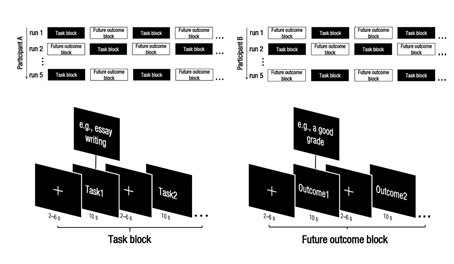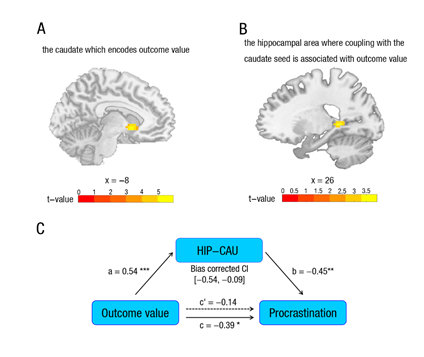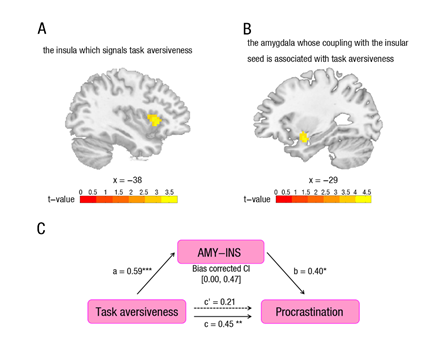“明日复明日, 明日何其多, 我生待明日, 万事成蹉跎”,一首“明日歌”道出了拖延的弊端, 它亦警示后人谨防拖延。然而,随着工作和生活节奏的加快,拖延似乎已成为这个时代的“流行病”。跨文化研究表明, 有15%~20%的成年人存在慢性拖延,超过70%的学生承认存在学业拖延,更有甚者演化为病理性拖延(Steel, 2007)。拖延不仅会严重影响人们的学习、工作绩效,还会降低人们的主观幸福感,进而损害人们的身心健康(Przepiórka et al., 2019)。
人们如何评估任务很大程度上决定了是否会拖延。充分地认识到任务的结果价值(结果价值),有助于减少拖延行为;而过多地关注于执行任务的负性过程(任务厌恶),则会加剧拖延行为。探明大脑如何评估任务的结果价值和任务厌恶不仅有助于揭示拖延的发生机制,也能为拖延行为的干预提供理论指导。
近日,冯廷勇教授团队在国际著名认知神经科学期刊Cerebral Cortex上发表了题为“Outcome value and task Aversiveness impact task procrastination through separate neural pathways”的学术论文。该研究发现:结果价值与任务厌恶通过两条独立的神经环路来影响拖延行为。具体而言,该研究采用自由建构范式(见图1)发现:人们能够自发地从结果价值和任务厌恶两个方面对任务进行评估。其中,结果价值由壳核进行表征并通过海马-壳核的功能耦合(the hippocampus-putamen coupling)减少个体的拖延倾向(见图2)。另一方面,任务厌恶则由前脑岛进行加工并通过杏仁核-脑岛的功能耦合(the amygdala-insula coupling)加剧个体的拖延倾向(图3)。由此可见,结果价值和任务厌恶对拖延行为有着独立的作用通路。因此,增强对任务结果的预期想象以及调控对任务的厌恶感都可以有效地减少拖延行为。

图1. 对结果价值和任务厌恶的自由建构范式

图2. 任务的结果效用通过海马-壳核的功能连接来减少拖延行为

图3. 任务厌恶通过杏仁核-脑岛的功能连接来加剧拖延行为
论文的第一作者为太阳集团tyc5997毕业的博士生张顺民(现为浙江大学特聘研究员),华南师范大学心理学院的陈琦教授和太阳集团tyc5997的冯廷勇教授为共同通讯作者。该研究得到国家自然科学基金面上项目(31971026)和中央高校基本科研业务经费创新团队项目(SWU2009104)支持。
文章索引
Shunmin Zhang, Tom Verguts, Chenyan Zhang, Pan Feng, Qi Chen*, Tingyong Feng*(2021). Outcome Value and Task Aversiveness Impact Task Procrastination through Separate Neural Pathways, Cerebral Cortex, bhab053, https://doi.org/10.1093/cercor/bhab053
原文摘要
The temporal decision model of procrastination has proposed that outcome value and task aversiveness are two separate aspects accounting for procrastination. If true, the human brain is likely to implicate separate neural pathways to mediate the effect of outcome value and task aversiveness on procrastination. Outcome value is plausibly constructed via a hippocampus-based pathway because of the hippocampus’s unique role in episodic prospection. In contrast, task aversiveness might be represented through an amygdala-involved pathway. In the current study, participants underwent fMRI scanning when viewing both tasks and future outcomes, without any experimental instruction imposed. The results revealed that outcome value increased activations in the caudate, and suppressed procrastination through a hippocampus-caudate pathway. In contrast, task aversiveness increased activations in the anterior insula, and increased procrastination via an amygdala-insula pathway. In sum, this study demonstrates that people can incorporate both outcome value and task aversiveness into task valuation to decide whether to procrastinate or not; and it elucidates the separate neural pathways via which this occurs.





